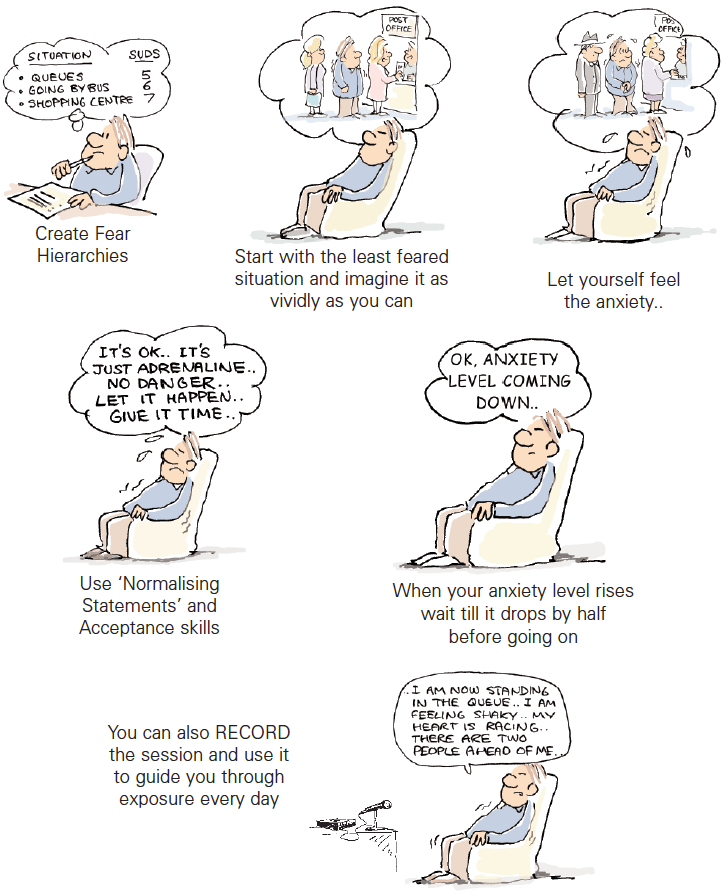Disclaimer: My content is NOT a substitute for professional advice, diagnosis, or treatment. When in doubt, ask a therapist!
Exposure therapy is about confronting your fears.
So, associating it with the word “fun”… might be a little bit of a stretch.
That being said, there are ways to make exposure less intimidating. Here are a few ideas:
Document your learning
By virtue of evoking anxiety and other difficult emotions, exposure therapy is rich with insights, which makes it rewarding. Without intentional reflection however, exposure can feel like unnecessary torture.
And that’s why it’s important to structure exposure like an experiment and keep track of whatever you learn in the process. By seeing your growth from one exposure to another, it will be a lot easier to keep practicing.
Gamify exposure therapy
In games, you fight horrifying monsters to level up (and to get cool items). In reality, you can do the same.
Every time you practice your exposure, give yourself a point (no matter how it went). After a certain number of points, reward yourself with something you like!
(Did someone say steak and wine? yum 😋)
You can also rename your exposure exercises to make them sound fun. For example, if you’re anxious about walking in public, you could call your exposure exercise “The Sexy Strut”.
Try VR
Speaking of games, it could be worth trying out VR apps.
While a meta-analysis shows that VR exposure is less effective than real-life exposure, I’m still excited about its potential, given how accessible it is and how underutilized exposure is in conventional therapy.
Here are two apps that seem promising:
- oVRcome (tested in a clinical trial)
- Innerworld (pending clinical trial)
If you can’t get your hands on a VR headset, here’s the good news: we all have free VR… and it’s called our imagination 🙂 In therapy, this is known as imaginal exposure, and here’s how it works:

Credit: CBT4Panic
Defy your anxiety
Show your anxiety who’s boss by rebelling against it! Specifically, whatever your anxious mind tells you to do or say, don’t follow it — just like a disobedient teenager would 🙂
To be clear though, this isn’t you fighting your anxiety or struggling against it. You’re accepting the presence of anxiety, but you’re refusing — playfully, defiantly — to let anxiety be in the driver’s seat of your life.
This approach is pioneered by Dr. Reid Wilson, Director of the Anxiety Disorders Treatment Center. In his words:
“We need to defy our limited beliefs about what our capabilities are. When we choose to engage in challenging activities and follow them through to their conclusions, we expand our sense of our capacity.”
Do a time-bound courage challenge
Starting exposure therapy is the hardest part. Then, staying consistent is.
To address both obstacles, I recommend….
- Frame your exposure exercises in the context of a courage challenge or comfort zone challenge (credit: Elizabeth DuPont Spencer, LCSW). This makes exposure therapy sound more exciting and less clinical!
- Introduce time constraints, specifically a cap on how many days you’ll be doing the challenge. Committing for a short time period feels easier, which will help with motivation.
As my long-time collaborator, Michael Simmons, beautifully wrote:
“We see this in people registering in droves for Spartan races, Marathons, Triathlons, Navy Seal workouts, and Tough Mudders. We see this in people challenging themselves to write a book in a month, learn a new language in three months, learn how to do a difficult dance in public in a year, or do 100 things that scare them in 100 days (more on these challenges below).
We want to do difficult things, because we know that pressure is what creates diamonds.“
Make your challenge public
Turning your courage challenge into a public project can increase your motivation for a few reasons:
- You make yourself publicly accountable
- You get support and encouragement from others
- You build your reputation and following
This might also work for exposure therapy. I will personally attest to that: That’s why I created Humans Of Sackville to force myself to interview strangers on the street.
Other examples include:
- 100 Days Of Rejection
- 100 Days Without Fear
- How to become more confident — lay down on the street for 30sec (recommended by Kimberly Morrow, LCSW)
Get an accountability buddy
Losing weight is easier when you have a friend cheering you on and checking in to make sure you’re on track. This applies to exposure exercises as well.
Your best bet is your therapist, since they will know how to professionally guide you through exposure, roleplay with you, and debrief after.
But even if you have a therapist to support you, your accountability buddy — say a family member or friend – can still play a pivotal role in supporting you.
Find the Goldilocks zone of anxiety
Too hard, you will give up. Too easy, you will coast along.
The key is to find that sweet spot where you’re feeling anxious enough, but not too anxious that you’re completely overwhelmed.

(Some therapists might make the case for flooding — where you start exposure therapy with your biggest fears — but it’s not for everyone.)
Acknowledge that exposure therapy sucks
While I’ve shared a list of ways to make exposure therapy fun, the reality is that exposure therapy is still gonna be hard.
And that’s a good thing! As Dr. Susan David said in an interview:
“Discomfort is the price of admission to a meaningful life”
Falling in love with emotional pain might be unrealistic, but you can at least cultivate an open attitude toward it. To do so, here’s a list of mindfulness exercises for you.
Related articles

